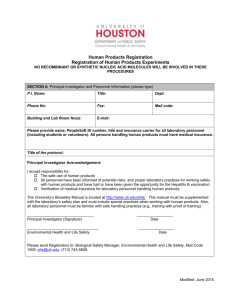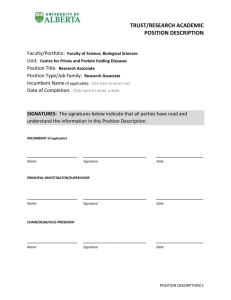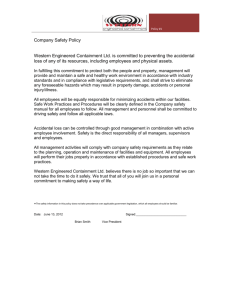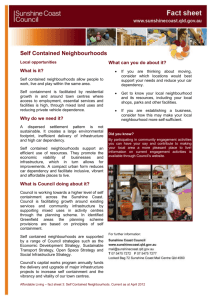November '06 - Strategies For Growth
advertisement
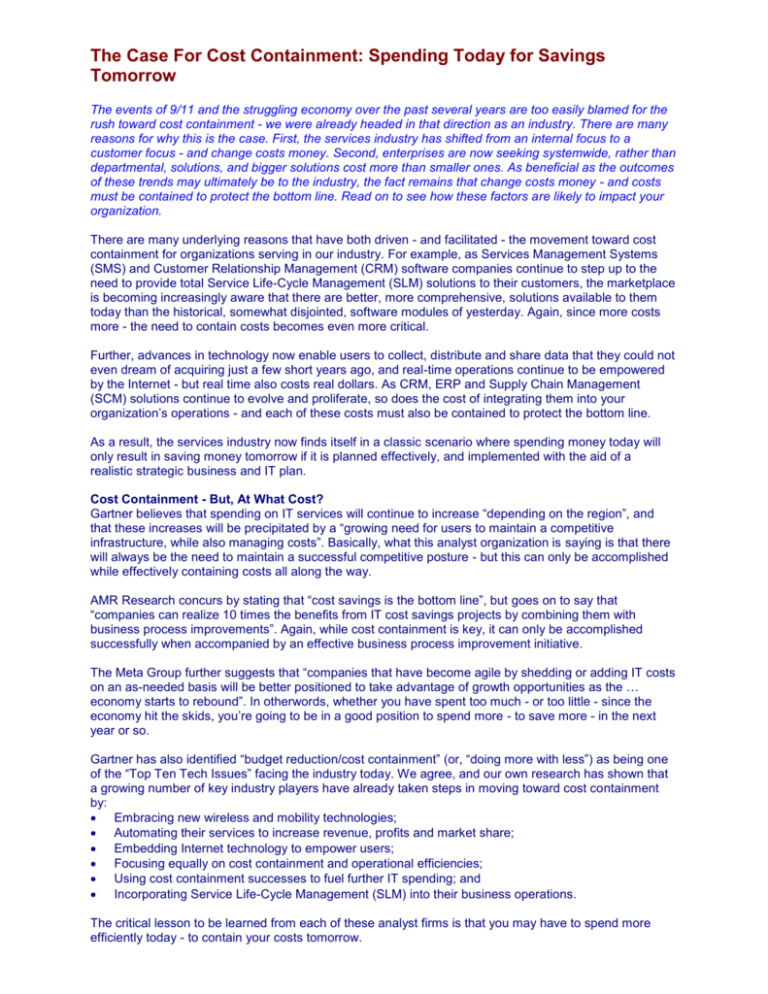
The Case For Cost Containment: Spending Today for Savings Tomorrow The events of 9/11 and the struggling economy over the past several years are too easily blamed for the rush toward cost containment - we were already headed in that direction as an industry. There are many reasons for why this is the case. First, the services industry has shifted from an internal focus to a customer focus - and change costs money. Second, enterprises are now seeking systemwide, rather than departmental, solutions, and bigger solutions cost more than smaller ones. As beneficial as the outcomes of these trends may ultimately be to the industry, the fact remains that change costs money - and costs must be contained to protect the bottom line. Read on to see how these factors are likely to impact your organization. There are many underlying reasons that have both driven - and facilitated - the movement toward cost containment for organizations serving in our industry. For example, as Services Management Systems (SMS) and Customer Relationship Management (CRM) software companies continue to step up to the need to provide total Service Life-Cycle Management (SLM) solutions to their customers, the marketplace is becoming increasingly aware that there are better, more comprehensive, solutions available to them today than the historical, somewhat disjointed, software modules of yesterday. Again, since more costs more - the need to contain costs becomes even more critical. Further, advances in technology now enable users to collect, distribute and share data that they could not even dream of acquiring just a few short years ago, and real-time operations continue to be empowered by the Internet - but real time also costs real dollars. As CRM, ERP and Supply Chain Management (SCM) solutions continue to evolve and proliferate, so does the cost of integrating them into your organization’s operations - and each of these costs must also be contained to protect the bottom line. As a result, the services industry now finds itself in a classic scenario where spending money today will only result in saving money tomorrow if it is planned effectively, and implemented with the aid of a realistic strategic business and IT plan. Cost Containment - But, At What Cost? Gartner believes that spending on IT services will continue to increase “depending on the region”, and that these increases will be precipitated by a “growing need for users to maintain a competitive infrastructure, while also managing costs”. Basically, what this analyst organization is saying is that there will always be the need to maintain a successful competitive posture - but this can only be accomplished while effectively containing costs all along the way. AMR Research concurs by stating that “cost savings is the bottom line”, but goes on to say that “companies can realize 10 times the benefits from IT cost savings projects by combining them with business process improvements”. Again, while cost containment is key, it can only be accomplished successfully when accompanied by an effective business process improvement initiative. The Meta Group further suggests that “companies that have become agile by shedding or adding IT costs on an as-needed basis will be better positioned to take advantage of growth opportunities as the … economy starts to rebound”. In otherwords, whether you have spent too much - or too little - since the economy hit the skids, you’re going to be in a good position to spend more - to save more - in the next year or so. Gartner has also identified “budget reduction/cost containment” (or, “doing more with less”) as being one of the “Top Ten Tech Issues” facing the industry today. We agree, and our own research has shown that a growing number of key industry players have already taken steps in moving toward cost containment by: Embracing new wireless and mobility technologies; Automating their services to increase revenue, profits and market share; Embedding Internet technology to empower users; Focusing equally on cost containment and operational efficiencies; Using cost containment successes to fuel further IT spending; and Incorporating Service Life-Cycle Management (SLM) into their business operations. The critical lesson to be learned from each of these analyst firms is that you may have to spend more efficiently today - to contain your costs tomorrow. The Road to Cost Containment Success Accordingly, we believe that the principal steps a services organization must take to build and implement a successful cost containment program are to: First, build a realistic Strategic Business Plan (i.e., know where you’re going - and plan accordingly for how to get there); Gain total management and end user “buy-in”; Work in behalf of all departments/functions (don’t rob Peter to pay Paul); Select the most appropriate software, platform and functionality to attain your goals; Establish realistic metrics - and continually track your performance; and Manage expectations at all levels (i.e., by articulating and communicating the value). However, cost cutting simply for the sake of cost cutting suggests that an organization is unable to see the “big picture”. You need to have a plan - and a vision - before putting any cost cutting measures in place, otherwise you run the risk of creating an unwanted “ripple effect” that may ultimately result in a negative impact on your customer service and support performance, and corresponding levels of customer satisfaction. The failure to set - and meet - realistic ROI goals, coupled with the absence of a formal plan for reinvesting present cost savings into future spending, will also reduce the prospects of any long-term cost containment success. Cost containment may have gotten your organization this far - but, operational efficiency will take you the rest of the way. However, operational efficiency without cost containment - well, you probably can’t afford it! It is our belief that the cost containment initiatives an organization takes today will be instrumental in its ability to manage growth - and profitability - in the future. Simply cutting costs alone won’t get the job done - but, containing costs through a well-defined and implemented Service Life-Cycle Management program will. Ultimately, cost containment will work best for your organization if you have a strong enough business plan in place to ensure that what you invest today will pave the way for containing your costs tomorrow. Until next month, keep your customers satisfied! Bill William K. Pollock President Strategies For GrowthSM P.O. Box 1024 Westtown, PA 19395 USA Tel: (610) 399-9717 Fax: (610) 399-9718 E-Mail: mailto:wkp@s4growth.com Website: http://www.s4growth.com



